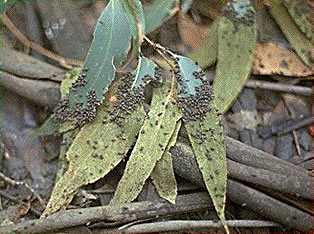Nutrient Cycling: Decomposition
The litter layer is comprised of accumulated leaves and other plant components in various stages of decomposition.
Its uppermost horizon consists of freshly fallen litter. Deeper horizons contain partially and well decomposed litter,
grading eventually into the mineral soil.
Some of the physical breakdown (disintegration rather than decomposition) of litter is carried out by the soil arthropods
and other soil and litter fauna. Fungi and bacteria do the rest, slowly transforming all recognisable plant components into humus.
Although not as obvious as the litter cycle, the production and decomposition of roots (particularly fine roots which are relatively short-lived) contributes a major proportion of total nutrient return.

Freshly fallen litter includes green twigs and foliage dislodged by wind. Here such foliage is being skeletonised by Cryptocephalus larvae. Most of the nutrients in these leaves will be quickly returned to the soil through the larvaes' frass but the remaining leaf tissue is high in lignin and may take months or years to be decomposed.
